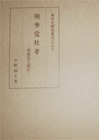Home > Book Detail Page

Oriental Research Series No.50
The Dong-Lin Movement and the Restoration Society in the Late Ming
700 pages
ISBN: 9784876985074
pub. date: 02/96
Written Language: Japanese
- Price : JPY 17,476 (with tax: JPY 19,223)
-
Out of Stock
Preface Kenji Shimada
Introduction
1. The Dong-lin Party and Zhang Ju-zheng;With particular attention to the kao- cheng-fa
1-1 Zhang Ju-zheng’s kao-cheng-fa
1-2 Oppression of students and academies
1-3 The central government and regional society
2. Foreign relations in the early Wan-li period
2-1 Zhang Ju-zheng and the peace talks between China and the Mongols in 1571
(1)The proceedings of the peace talks of 1571
(2)The families of Zhang Si-wei and Wong Chong-gu
(3)The bureaucracts of Shan-xi province and Zhang Ju-zheng’s government
(4)Conclusion
2-2 The political dispute over negotiations for peace between Ming China and Japan
(1) The Zhao-he incident
(2) Peace negotiations
(3) The effort to defend China
3.The formation of the Dong-lin Party
3-1”Wan-li-di-chao” and ”Wan-li-shu-chao”
3-2 The formation of the Dong-lin Party
(1) The Meaning of yan-lu
(2) The bureaucrats responsible for political scrutiny
(3) The independence of the authority of inspection
(4) The development of criticism of Shen Shi-hang
(5) National polisy and the popular voice
(6) The Don-lin Party’s declaration of intent to serve the public
4. The Don-lin Academy and the Party
4-1 Gu Xian-cheng and Gao Pang-long
4-2 The formation of the Don-lin Academy
4-3 The network of academies in Jiang-nan
4-4 The network of four major academies
4-5 The Academy and the Party
5. The Don-lin Party and Li San-cai
5-1 Li San -cai and mining levies and sales tax disaster
5-2 The theory of monarchy
5-3 After the mining levies and sales tax disaster
5-4 Conflicts between the the Don-lin Party and it’s opposition
6. Political activity during Tian-qi period
6-1 The Three Cases
6-2 The Liao -dong affairs and Shou-shan Academy
6-3 A drastic development : Yang-lian’s accusation
6-4 Suppression
7. The Restoration Society movement
7-1 Ying –she membership
7-2 The formation of the Restoration Society
7-3 The policy and organization of the Restoration Society
7-4 A renaissance of ancient studies
7-5 The Restoration Society in political context
7-6 The appeal from student in Nan-jing
7-7 The formation of the zhou yan-ru’s Cabinet
7-8 The fall of the Ming dynasty and Restoration Society
8. Party conflict under the Nan-jing government
8-1 The enthronement of Fu-wang
8-2 The treatment of the eunuch party and of those who surrendered to Li Zi-cheng
8-3 Civilian officials and military officers
8-4 A black list; Huang-nan-lu
9. The people of the Restoration Society and the registance movement
9-1 Around Tai-hu
9-2 Zhe-dong
Conclusion
Afterward
Appendix ; List of members of the Dong-lin Party
Index
Introduction
1. The Dong-lin Party and Zhang Ju-zheng;With particular attention to the kao- cheng-fa
1-1 Zhang Ju-zheng’s kao-cheng-fa
1-2 Oppression of students and academies
1-3 The central government and regional society
2. Foreign relations in the early Wan-li period
2-1 Zhang Ju-zheng and the peace talks between China and the Mongols in 1571
(1)The proceedings of the peace talks of 1571
(2)The families of Zhang Si-wei and Wong Chong-gu
(3)The bureaucracts of Shan-xi province and Zhang Ju-zheng’s government
(4)Conclusion
2-2 The political dispute over negotiations for peace between Ming China and Japan
(1) The Zhao-he incident
(2) Peace negotiations
(3) The effort to defend China
3.The formation of the Dong-lin Party
3-1”Wan-li-di-chao” and ”Wan-li-shu-chao”
3-2 The formation of the Dong-lin Party
(1) The Meaning of yan-lu
(2) The bureaucrats responsible for political scrutiny
(3) The independence of the authority of inspection
(4) The development of criticism of Shen Shi-hang
(5) National polisy and the popular voice
(6) The Don-lin Party’s declaration of intent to serve the public
4. The Don-lin Academy and the Party
4-1 Gu Xian-cheng and Gao Pang-long
4-2 The formation of the Don-lin Academy
4-3 The network of academies in Jiang-nan
4-4 The network of four major academies
4-5 The Academy and the Party
5. The Don-lin Party and Li San-cai
5-1 Li San -cai and mining levies and sales tax disaster
5-2 The theory of monarchy
5-3 After the mining levies and sales tax disaster
5-4 Conflicts between the the Don-lin Party and it’s opposition
6. Political activity during Tian-qi period
6-1 The Three Cases
6-2 The Liao -dong affairs and Shou-shan Academy
6-3 A drastic development : Yang-lian’s accusation
6-4 Suppression
7. The Restoration Society movement
7-1 Ying –she membership
7-2 The formation of the Restoration Society
7-3 The policy and organization of the Restoration Society
7-4 A renaissance of ancient studies
7-5 The Restoration Society in political context
7-6 The appeal from student in Nan-jing
7-7 The formation of the zhou yan-ru’s Cabinet
7-8 The fall of the Ming dynasty and Restoration Society
8. Party conflict under the Nan-jing government
8-1 The enthronement of Fu-wang
8-2 The treatment of the eunuch party and of those who surrendered to Li Zi-cheng
8-3 Civilian officials and military officers
8-4 A black list; Huang-nan-lu
9. The people of the Restoration Society and the registance movement
9-1 Around Tai-hu
9-2 Zhe-dong
Conclusion
Afterward
Appendix ; List of members of the Dong-lin Party
Index









